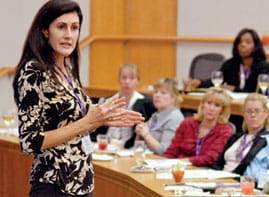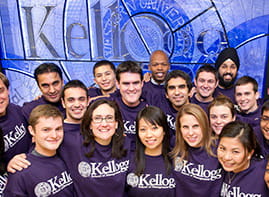More than 150 million girls didn’t go to school this morning. Here’s what John Wood ’89 is doing about it
1/16/2009 - John Wood ’89 was sitting in a coffee shop, reading the
New York Times, when he saw the headline: “Afghan Girls, Scarred by Acid, Defy Terror, Embracing School.” Eleven girls in Afghanistan had been doused with acid, the story said, because they tried to go to school.
The news came at a pivotal time for Wood, founder/CEO of Room to Read, who was considering postponing the launch of a girls’ scholarship program in Bangladesh due to funding issues. The article changed his mind. “I said [to myself], ‘I am
not cutting the number of girls in our scholarship program because of the current global financial crisis,” said Wood. “How we respond to adversity and tragedy says a lot about us as leaders. There are a lot of dark forces out there that are going to try to impede human progress. Our biggest question is, ‘What is our response going to be?’”
Wood shared his response during a recent two-day visit to the Kellogg School. On Jan. 13, he discussed “Lessons Learned from Scaling a Social Enterprise” with Part-Time MBA students at Wieboldt. On Jan. 14, he met with nonprofit executives in Chicago and participated in a “Book Club” lunch with 25 students from the Kellogg Social Enterprise Club. That evening, Wood engaged in a Q&A moderated by Dean Dipak Jain on the Evanston campus.
Wood was inspired to found Room to Read in 1999 after taking a backpacking trip though Nepal, where he witnessed deteriorating schools and met children so desperate for an education that they begged for pencils instead of money. He was so moved by the experience that he quit his high-paying job at Microsoft to devote himself full-time to providing educational opportunities for children in developing countries. Since then, Room to Read has built 750 schools, established 7,000 libraries, donated 5 million books and funded 7,000 long-term girls’ scholarship in rural villages located in Nepal, Vietnam, Cambodia, Sri Lanka, Laos and Bangladesh.
“We need leaders like John to focus on the basic responsibility in all of us — educating people at all levels,” Dean Jain said. “When people ask me what I mean by ‘success to significance,’ I tell them, ‘John Wood.’”
Throughout his visit, Wood was open to answering questions from Kellogg students, faculty and staff. Here are just a few that arose.
What is your long-term vision for Room to Read, particularly in terms of girls’ education?
Think about breast cancer: Breast cancer awareness used to be marginalized; it didn’t get the funding it deserved. And somehow, through the campaigns, the pink ribbon became ubiquitous, millions of dollars were raised, and it became a tier-one issue. Look at the fact that 150 million girls in the developing world woke up this morning and didn’t go to school. Why aren’t we marching in the streets over that issue? Especially when it costs 250 dollars per girl per year to change that. So my hope would be that we can build an army of people to make the girls’ scholarship program their issue. And I’d like to see a bunch of strong businesswomen leading that charge.
Are you adjusting your fund-raising strategies to cope with the economic downturn? One of the things I’m doing is spending more time fund-raising overseas. Unfortunately, this recession is going to be worldwide, so we’ll see whether or not that’s the correct strategy. We’re also asking some of our more loyal donors to step up and front-end their donations. And we’re probably going to have more realistic goals when we have an event — like trying to raise $25,000 instead of $200,000.
What are some of the advantages of having an international fund-raising base? As one example, when Katrina hit in September 2005 — which was in the middle of fund-raising season — we knew that we had to forget about domestic fund-raising for the next eight to 12 weeks. So my team put me on a plane, and I went to London, Switzerland, Hong Kong and Singapore. I raised a couple million dollars in a month. Last year I spent more time than ever in England, because the pound was two for one. So every time we raised a pound, it was like raising two dollars.
How did your time at Microsoft enable you to make Room to Read a success? At Microsoft, we learned no goal is too big. Robbie Bach [at that time the head of the Office Marketing team] once told our team that we would take our share of the office suite category from single digits to 80 percent. When there was uproar, he said, “If you don’t think 80 percent is possible, then you should not be in this group. That’s what we’re going for.” And I like that, because sure enough we ended up not only hitting, but beating, that goal. After we set up our first 10 libraries, we said that our goal was to reach 10 million children by the year 2020. It seemed like an audacious thing to say. But guess what? We’re actually on track to meet that number by 2018, so we’re about two years ahead of schedule.






